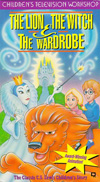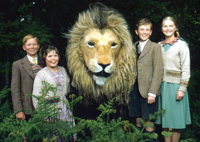At last, in less than two weeks, The Chronicles of Narnia will appear on the big screen for the first time ever. However, this much-hyped movie does not quite mark the first time that cameras have rolled on The Lion, the Witch and the Wardrobe. The book, first published in 1950, has been dramatized at least three times before—but always for television.
Each of these earlier productions was made with much less money than the typical big-screen movie, and all of them were made at least a couple of decades ago, before computer-generated images had become the norm. So, on a visual and technical level, they are not nearly as impressive as the fantasy films that we have since become used to.
They were also made with an explicitly young audience in mind, and as such, they tend to paint their characters in rather broad strokes. The White Witch does a lot of shrieking, and the children sometimes deliver their lines rather earnestly or deliberately, as though they were still memorizing their dialogue but had not yet learned to speak it naturally.
According to the Internet Movie Database, this story was first broadcast on British television as a ten-part black-and-white mini-series in 1967, less than four years after C. S. Lewis’s death. This version does not seem to be available on video. Two later adaptations, however, have been released on VHS and DVD multiple times, and are easy to find.
 |
In the summer of 1979, the CBS network broadcast a cartoon-animated version produced by the Children’s Television Workshop (Sesame Street, The Electric Company) and the Episcopal Radio-TV Foundation. It was directed by Bill Melendez, a former Looney Tunes animator who had since become well-known as the producer of numerous Charlie Brown specials.
At 95 minutes, this is a fairly brisk and economical adaptation. While it covers all the major plot points and much of the character development from Lewis’s book, it leaves out some of the more minor details, such as how the children enter Narnia almost by accident while hiding in the wardrobe from Mrs. Macready, or how a robin leads the children to Mr. Beaver; instead, Mr. Beaver leads the children away from Mr. Tumnus’s ransacked home himself.
This version also makes one interesting deviation from the structure of Lewis’s novel, at the very beginning. It skips over the children’s arrival at the Professor’s house entirely, starting instead with Lucy emerging from the wardrobe and telling her three older siblings that she has been to Narnia. When they don’t believe her, Lucy retreats to her room and reminisces about her first meeting with the faun Mr. Tumnus, which is then shown in flashback.

The most conspicuous omission from this film is the scene of Father Christmas giving the Pevensie children their gifts. While we hear about Father Christmas and the gifts he gives to others, we never see him, himself; instead, it is Aslan who gives the children their gifts.
Some of the performances tend to be over-the-top; and the characters occasionally look at the camera when someone says something particularly unusual or scary, or they make subtle asides to it, as though they were participating in a panto or some similar form of children’s theatre in which the characters address the audience directly.
When Edmund meets the White Witch, she yells her lines at the very moment when she is supposed to be enchanting him. And the wolf who leads the Witch’s secret police growls ostentatiously before, after, and during most of his lines. At least Aslan’s booming baritone conveys his power and authority, as well as his warmth and even humor.
The animation is somewhat crude, even by the standards of a quarter-century ago, and it occasionally falls back on questionable devices; for example, when the White Witch turns her enemies to stone, her wand seems to shoot laser beams at her victims (a consequence, perhaps, of the fact that Star Wars came out only two years earlier?).
However, some of the gimmicks are kind of fun—like the portrait in Mr. Tumnus’s house which comes to life for just one second, to blow a note on the faun’s flute. And when the grown-up Kings and Queens of Narnia pursue the White Stag, that sequence surges with life thanks in no small part to the Emmy-winning score by Michael J. Lewis.
 |
Until now, the only readily available live-action version of this story has been a three-hour dramatization produced by the BBC in 1988, and shown in the United States on the WonderWorks program. This version owes its great length partly to the fact that it has retained almost everything from Lewis’s book, but it is also rather slowly paced.
The script, by Alan Seymour, also introduces some new material. This time, the story begins in London in 1940, as the Pevensie children are put on a train and sent to the Professor’s house in the country. Edmund, who will go on to betray his siblings to the White Witch, reveals his wicked tendencies when he complains that their parents are “spoilsports” for sending them away instead of letting them enjoy the excitement of the war.
However, once the children are inside Narnia and Edmund heads for the White Witch’s castle to give them all away, he begins to wrestle with his own conscience, depicted here as a sort of ghostly copy of himself that emerges from his body to talk to him every now and then. At one point, after talking to this doppelganger, Edmund tells it to “disappear.”

Once again, the production values are more like those of a night of children’s live theatre than those of a movie, per se. The fauns, who are supposed to be humans with goats’ legs, look instead like humans wearing baggy, shaggy pants. And because the Beavers are portrayed by regular-sized people—and not by, say, dwarves or midgets, or Yoda-like puppets—they look monstrously huge. Aslan, for his part, is a big let-down—more of a giant, soft-spoken plush doll with a loud purr than the roaring king of beasts.
Interestingly, some of the more fantastical creatures are depicted not through puppets or costumes, but through old-fashioned hand-drawn animation, which is then superimposed on the live-action images. In a way, this is a lot like the current way of doing special effects, which consists of animating creatures on a computer before adding them to a shot.
The BBC version includes the Father Christmas episode; however, like the cartoon, it leaves out some of the mythological references in Lewis’s original novel that might rub some Christians the wrong way. These include the bit where Mr. Beaver explains that the White Witch is not human because she is descended from Lilith—a demonic being who was Adam’s first wife, according to medieval Jewish legend—as well as the bit where Mr. Tumnus regales Lucy with stories of how the Roman god Bacchus and his drinking buddy Silenus feasted with the forest people. (This last element becomes especially important in Prince Caspian, but the BBC eliminated it from their adaptation of that book, too.)
Seymour’s script also adds a curious bit of dialogue after Aslan comes back from the dead and explains the Deeper Magic. Susan and Lucy ask why he didn’t tell them that he knew he would rise again (a fair question, since Jesus had predicted his own resurrection to his disciples), and Aslan replies, “I knew of the old incantation, but it has never been put to the test, until now.” The girls then marvel that Aslan took such a “risk”—as though he had been uncertain of the outcome. Some critics, like Steven D. Greydanus, have said this line is “rank heresy” against Aslan’s omniscience.
This BBC production was followed by two sequels—one a compression of Prince Caspian and The Voyage of the Dawn Treader, and the other an adaptation of The Silver Chair—and the production values get better as they go. (A boxed set of all three BBC productions is available here).
Here’s hoping that the upcoming big-screen version of the story gets the production values and the basic story right, right from the start, and that it is a big enough success to generate a new set of sequels.
Image of 1988 cast © BBC
Copyright © 2005 Christianity Today. Click for reprint information.










